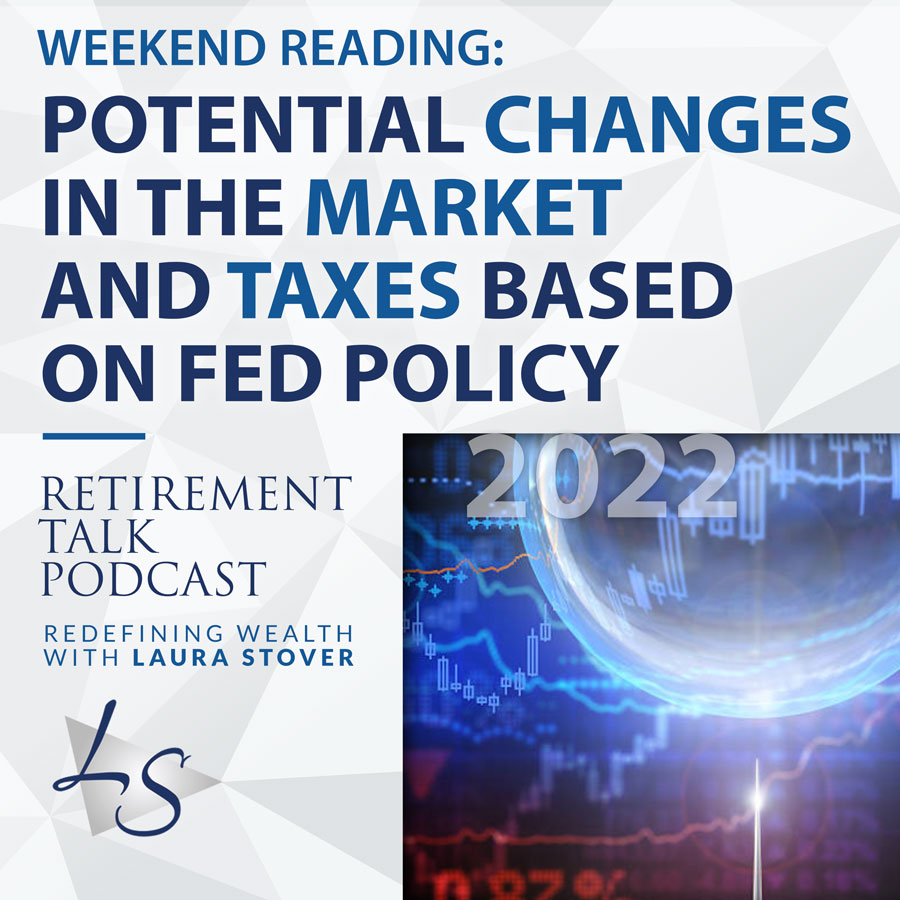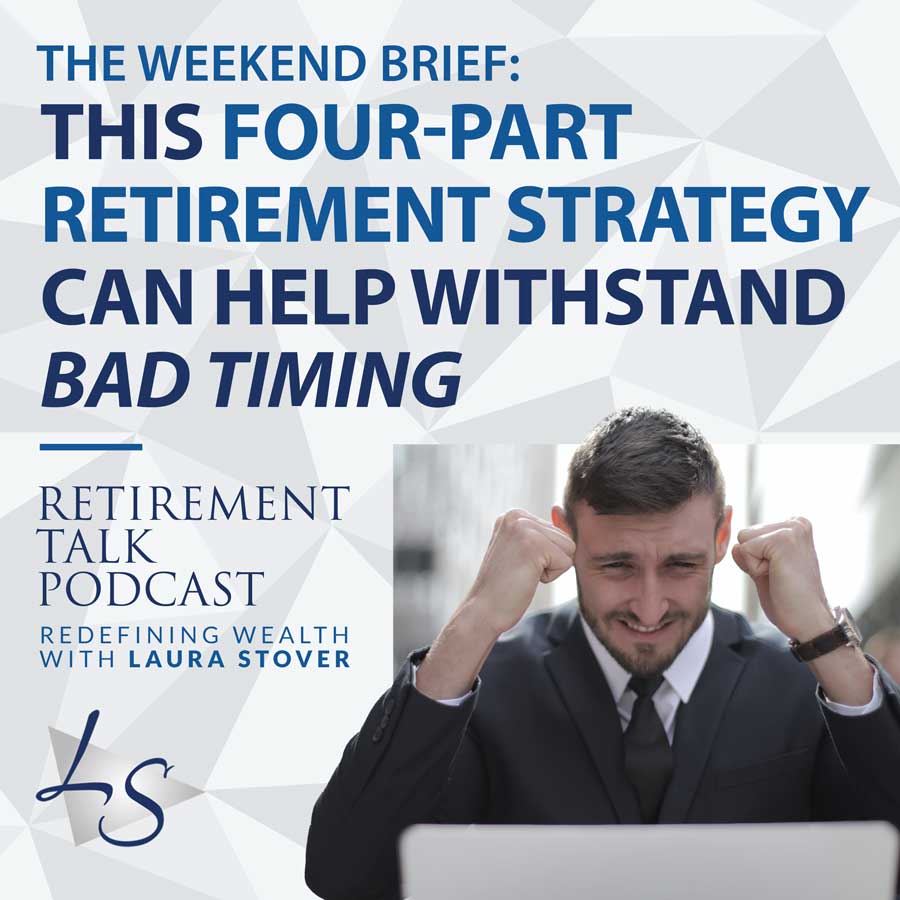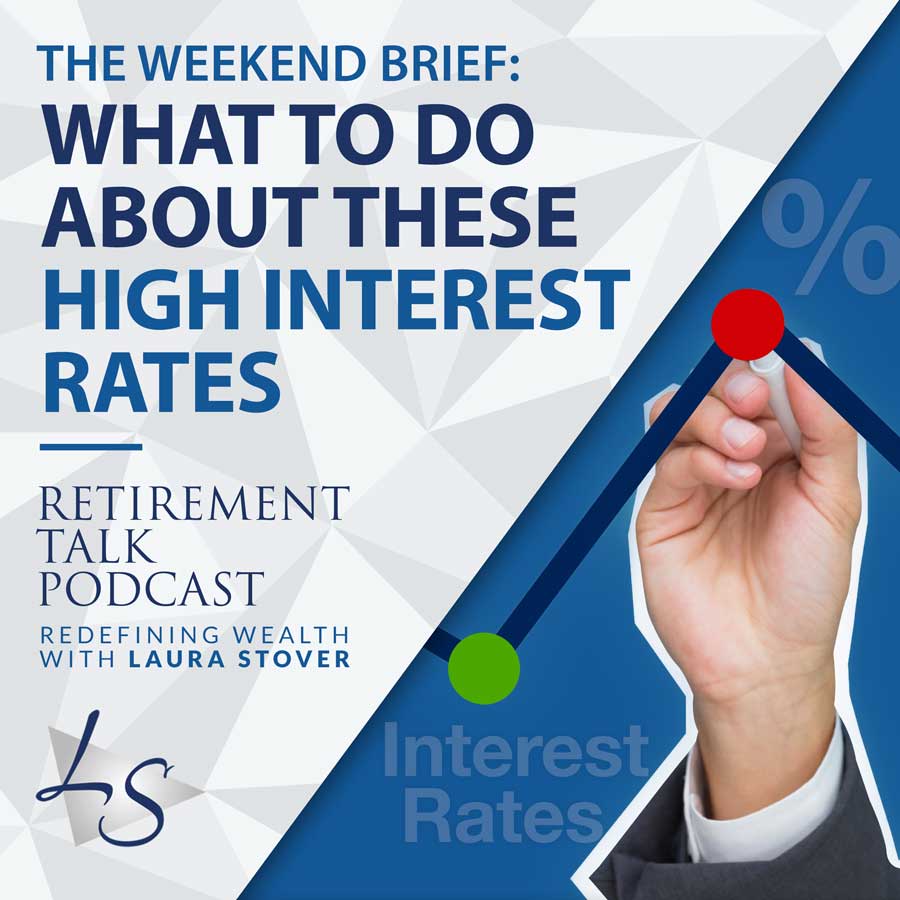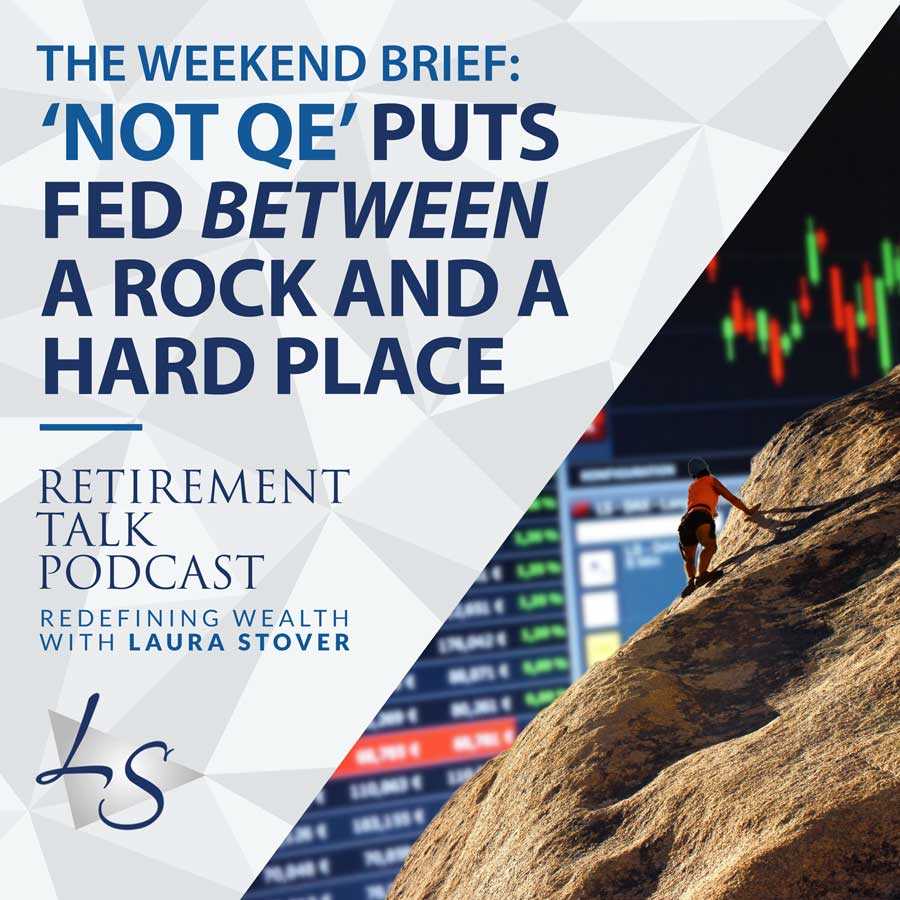With the recent dip in the market around the holidays, we’re seeing a lot of conversations around the potential changes over the next ten years that lead to the idea of an upcoming rough year for investors.
In this episode, we’re debunking some of the ideas that the 2022 market will be bad for investors based on historical data. Listen in as we discuss a few important details you need to know about your taxes, your investments, and potential changes coming in the next few years.
Review the article mentioned in today’s show >>
Rate & Review the Podcast on your favorite podcast app!
Show Notes:
Team Approach to a Proactive Tax Strategy (3:44)
Roth Conversions in Tax Strategies (4:26)
Potential Changes in Taxes (4:58)
- Prohibiting Roth IRA Conversions for Wealthier Tax Payers
- Capped Aggregate Account Balances
Backdoor Roth IRA (16:34)
Market Volatility Over the Holidays (19:51)
Hawkish Fed Policy (22:47
Dove Fed Policy (23:17)
Perspective, Mindset, & Balance (25:18)
Triple Compounding in Reverse (27:48)
Links
Listen & Subscribe
Review the Transcript:
Ron Stutts:
Welcome to Retirement Talk, the Redefining Wealth Show, your source for financial information for pre-retirees and retirees. We are here to help you better navigate during these financial times. We’re here to discuss thoughts and ideas with some of today’s foremost experts in the field of finance and retirement, as well as discuss trending topics and the impact of major legislation that could impact your bottom line. We will break it all down. These discussions can help you make better financial decisions and be informed so you can live the lifestyle you imagine and make better financial choices.
Ron Stutts:
Laura Stover is a registered financial consultant and CEO of LS Wealth Management, as well as founder and owner of the LS Tax, a consulting firm. She’s been featured in Forbes, CNBC, and The Wall Street Journal. I’m Ron Stutts. Our topic for today is all about what 2022 holds and strategies you should implement today to be better prepared for tomorrow. If you’d like to learn more on today’s topic, head on over to redefiningwealth.info and schedule a strategy session. Now, here are your hosts for today’s show, Wealth Advisor, Laura Stover, and Certified Financial Planner, Michael Wallin.
Laura Stover:
Hello, hello, hello, and Michael, welcome to this week’s retirement talk. How are you?
Michael Wallin:
Doing great, Laura. How are you today?
Laura Stover:
Oh, it’s been a very, very busy week. Well, you’ve been with me most of the week. We’ve spoken with a lot of clients, and I think that is appropriate to say as we’re approaching the end of 2021, there are a lot of questions that we have gauged with clients, a lot of listeners to the show. Thank you for listening, and some of you are taking advantage of going to redefiningwealth.info and clicking that schedule review button because you want a complimentary consultation. A lot of you are soon to retire, you are wanting to make sure you’re on the right path. And I think as everybody is wanting to be on the right path and wondering the big question and get your polisher out, Michael, for the crystal ball, what does 2022 have in store?
Laura Stover:
That is what we are going to discuss at today’s show. An article from BofA, and it was on the internet in markets.businessinsider.com, 2022 is shaping up to be a bad year per the article for the stock market as investors grapple with three shocks. Well, I don’t know that I agree entirely with the title of this article. We are certainly seeing some things in question, as we approach the end of the year and like myself, many clients have had questions. What will the market do? What will the impact of fed policy? How will that affect my retirement account? We have a lot of questions we’re filled in terms of, should I do a Roth conversion? So I think we’re going to focus on taxes, Michael, and the second part of the show, then a little more time spent in terms of what the market is looking like.
Laura Stover:
We saw Black Friday take a little bit of a nose bleed. We’ve seen ongoing volatility. Let’s dive right into this week’s show and beginning with a proactive tax strategy. Now, many clients have taken advantage of consulting with our CPA, and you’ll hear us often speak about the team approach. I do not believe that any one person, if you are just exclusively consulting with one advisor and you are counting on them to do everything for you, that must be an exceptionally bright person because it is requiring a CPA specialist, certified financial planners, case planners, legal experts. And we want that team approach with some of these questions.
Laura Stover:
And the first item on here is really a discussion, Michael, about Roth conversions. And we provide the tools with our CPA team to our clients evaluate that cost analysis. What is it going to cost to do the conversion? How much can I convert? And that is very insightful for many of our clients. So being proactive with these tax strategies, it’s one of the pillars of the redefining wealth process. So if we first hit this topic on taxes, there are some changes around the corner for 2022, 2029. Let’s talk about some of those potential changes first regarding the ability to convert a Roth and how that may be impacted going forward. This is a big one.
Michael Wallin:
Absolutely. And now we’re looking at the House bill that is being evaluated right now. It is still in the bill that Roth conversion limits will be put in place. The House bill is prohibiting Roth IRA conversions from wealthier tax payers, those individuals earning more than $400,000 as an individual or as a couple earning more than 450,000. And going into the bill that that restriction would actually take place in 2032. So even though we’re looking at adding it now, there’s still a 10 year window for individuals at that higher income level, still being able to make Roth conversions over the next 10 years, but then it would limit that going into 2032 at those income levels.
Michael Wallin:
So, that’s a huge part of a lot of people’s strategy. As we have looked at over the years, people have thought, well, I’ll get to those retirement years and then I’m going to take my 401k and then I’m going to bump the bracket. I’m going to start taking money out of my IRA or my 401k, I’m going to start converting that over into a Roth account so I can mitigate and control my taxes in the future. Well, you better start planning and making adjustments because these limits get passed by the Senate we will start seeing those higher earners not being able to take advantage of it.
Laura Stover:
When you think about it as an individual or a couple it’s only 50,000 a year more as a couple. 450,000 as a couple these days, if you’re living in a state like California, now it’s beautiful, beautiful state, but we know how expensive it is to live in states like… 450,000 between two people, it’s not really… I mean, that’s a nice income depend upon the lifestyle you’re wanting to live, but that’s a lot of upper middle class individuals, that’s not really wealthy in my opinion. What do you think? As far as that cutoff to say, if I’m an individual at 400,000, that seems a bit lopsided when there’s a 50,000 more only as a couple.
Michael Wallin:
I found this to be very interesting. Last week as I was on Thanksgiving break, I was watching TV and it seems that Whoopi Goldberg, I have finally agreed with something that she had to say on The View. She came out.
Laura Stover:
Drum roll.
Michael Wallin:
She came out with a same complaint saying that somebody at $400,000 of earned income is not the upper 1%. They are not the one percenters of our population. And she was complaining that that number is too low. So I think that’s important as we look at it is we are getting it into middle class America, we are getting into those individuals that may be small business owners that may have that type of income, but when we’re limiting their ability to make sure their revenue is going to last, or their earnings is going to last throughout their retirement, that has impact because what if they start selling off small business or we start seeing other decisions that they make that eliminates jobs, what’s going to be the impact in local communities because of this fed bill that’s being looked at right now?
Laura Stover:
Yeah, and I’d say that’s a big whoopty doo if I thought the same thing that Whoopi… So I think that could be a unanimous consensus, but everyone’s so polarized these days. It’s not going to be an agreeable viewpoint to see if we put our heads in a bag and we both give an opinion without hearing the other side’s opinion then we come out to the whoopty doo, it is not the upper 1% by any means. So the message here is if you have most of your retirement assets, and this is the thing, when you do the internal rollover, if you’re soon to retire with your 401k and you do the internal rollover to a fidelity type of, I’m not picking on anybody, but if you do like an internal rollover, you’re not going to get some of the strategic planning that you need to put in place today to mitigate some of these changes that are forthcoming to really understand what the rules are.
Laura Stover:
They’re changing rapidly in terms of these discussions, and really is your favorite word and I like this word now to unpacking it all, can be convoluted and you really have to be on top of this with a forward looking approach. Taxes are something that requires being very proactive. So if you have the bulk of your wealth right now in these large retirement accounts, check that off is something immediately that you need to have on your radar about the amounts that you should be converting now because the target year where this potentially could change is 2032. It is not that far down the road, and they could always move this up sooner. Things are happening rapidly. Now the next part of this whole thing, let’s explain what aggregate account balances are in terms of IRA accounts. They’re also looking at capping these aggregate account balances.
Laura Stover:
This bill would prohibit individuals if you have an aggregate savings. So this is probably the upper higher net worth now at 10 million or more in tax advantaged retirement accounts and if your income though is above 400,000 from making any more contributions. So if you’re in these income limits, and of course we always know it starts at one place in the House and it ends up looking different in the Senate. But what they’re eyeing right now is if you exceed where they ultimately put this criteria as an individual, you are going to be required regardless of your age, to take an RMD from these accounts. That’s huge and that is on the agenda for 2029. I can’t even say years that far ahead, I feel like the Jetsons, 2029. So they want tax revenue, here in the next few years they’re really targeting these retirement accounts.
Michael Wallin:
Absolutely, and they’re even more stringent on rules that we’re seeing for individuals with 20 million or more. Again, like you’re saying, Laura, it’s looking at the federal government making fed policy to say, what can we do to get more revenue in to the coffers of the government? And I think that’s important that as they’re balancing this out… Now, this is on the House bill, it still has to go through the Senate and be passed. And those are the negative side to the high net worth but I think it’s noteworthy to look at the other side of the spectrum. And there’s a lot of listeners out here that I think would fit within this scope. They may be in the retirement years today, they have an IRA, they’re taking RMDs every year out of their accounts. However, when you’re looking at their social security and social security is not taxable in itself, it’s only taxable when other income is added to it.
Michael Wallin:
So individuals need to be talking to a tax expert, talking to a financial planner, going through the LS wealth process like we guide people through, because this week we were able to help a client that came along, has a very modest IRA and they were taking their RMDs out, because we’ve been helping everybody currently getting their RMDs out of their accounts, and simply ask them, why are you not taking out more of this? Because their RMD and their income, they still had a gap on what their exclusion rate was. Their personal deduction, they were not meeting that level and I advised them, go ahead and take more out. We’ll move that into a Roth and over the next four years, we’re going to be able to move that IRA from a taxable account… Housing taxation to the individual that over the next four years, we’ll be able to move all of those funds into a Roth.
Michael Wallin:
It will longer be taxable to the individual in the future because we’ll already pay taxes from the traditional going into the Roth. So any gains are tax free in that going forward, but even more important because our client was not needing those assets on an annual basis for income, it’s no longer going to be taxable to the beneficiaries in the future as well. The client was just elated and was like, this is a great strategy, I don’t know why my previous advisor did not share it with me. And again, it’s because not looking at things holistic, they were only looking at the investing side, not taking consideration of taxation, not considering distribution. And that’s why you have to really evaluate and are there advantages that you can take today to protect or create a better opportunity while you’re living, but also in what you distribute to the next generation?
Laura Stover:
So definitely the eye is on qualified retirement accounts with some of the proposed items that are just coming out now where some attention in Congress is… And really with the current administration’s viewpoint on where they want to eye tax revenue going forward. So Roth conversion limits based on your income is one and then aggregate account balances if you have multiple IRA accounts, there is a cap on these, as we just stated, they’re eyeing a change if your income or the balance in these accounts to be determined yet, exceed a certain amount. Their agenda would say, you regardless of your age, it’s not just the 72 anymore, regardless of age, now you’re going to have to start paying tax on these accounts with a distribution. That’s some of what is out there at the moment. Now, another area I did recently see, Michael this week, and maybe we’ll dedicate a show to this.
Laura Stover:
A lot of the diversification with tax structure comes in getting some of the money from the taxable tax deferred to that tax free bucket. And I did see where IULs or the life insurance world is changing that corridor with regards to MECs with some possible legislative changes going forward, that would allow a person to fund these a little more fully without paying that 10% distribution if you exceed and it becomes a modified endowment. So I don’t want to confuse listeners, but there’s a lot on the horizon with regards to tax changes. Another popular discussion revolves around the backdoor Roth IRA. Now this is not an official type of individual retirement account. It is just an informal name for a kind of complicated internal revenue service. It’s a sanctioned method for high income earners now, that you have an ability if you exceed the income limits to facilitate doing a Roth conversion, this is as it’s described a backdoor ways.
Laura Stover:
Purely legal if your income again, exceeds the limits that the IRS allows for regular Roth contribution. So basically a backdoor Roth, it’s not a special type of an account. They are traditional IRAs and 401k accounts that you can convert to a Roth IRA. So understanding this legal way to get around those income limits that normally restrict high income earners from contributing to our Roth. The backdoor Roth is not a tax dodge, it’s maybe even going to incur higher taxes initially when it’s established, but the investor will get the future tax savings of the benefits of having the Roth account. So let’s talk about this, beginning in 2022 individuals would be prohibited, that’s just next year, that’s weeks away, from converting after tax contributions to either the 401k are the traditional Roth.
Michael Wallin:
That has been a… Like you said, for high net worth individuals has been a great strategy over the years and what I call an in flight transfer and the taxation is created while the transition is done in flight. And then where does it land? Well instead of allowing the after tax dollars to land into a Roth account where all future gains within, as long as it met eligibility would be tax free, the government is basically saying, no, it’s going to be taxed, but it’s going to have to go into a non-qualified account because they’re wanting that any future gains in that contract or in that whatever the account is that is set up, that those gains are going to be taxable in the future. So again, it’s a way of saying, high net worth individuals we’re not going to allow you to continue growing your accounts on a tax-free basis in the future and pushing more of those dollar into current today taxation.
Ron Stutts:
Thanks for listening to this episode of the retirement talk podcast. To learn more about how we can help you redefine your wealth and make sure you’re on the right track, go to redefiningwealth.info and schedule a review. You’ll also be able to get access to today’s show notes along with a transcript, as well as the resources mentioned. Again, visit redefiningwealth.info/podcasts. Thanks again for taking the time to listen and be sure to tune in next week for another episode, the Retirement Talk Podcast with Laura Stover.
Laura Stover:
So some of what we may be looking at in 2022 and going forward is our featured article for today’s Retirement Talk, The Redefining Wealth Show, you’re listening to Laura Stover and Michael Wallin. So market volatility, we may end up 2021 with a few bumps. I’m personally buying more, but I think we want to put this in perspective. Our target audience that we are listening to is those folks nearing retirement. And we always call that little window, the bridge to retirement, is the five to seven years, ten years away, or you’re in retirement, you are welcome to listen to the show. So you’re learning some steps to take, but there’s specific strategies when it comes to the tax portion. And we spent the first part of the show discussing that, but now there’s a lot of questions, Michael, about market volatility. We had some turmoil in the market, Black Friday, we saw a steep decline.
Laura Stover:
In fact, it was the worst Black Friday on record in about 70 years. Now, if we put corrections into perspective, this is one aspect of what I want to discuss. And then a few of the shocks that are contributing to some of this volatility regarding payroll recoveries, inflation, rising interest rates. Some of these things and the virus obviously was a big impetus for why we had the turmoil that we did on Black Friday and subsequently the following Monday it was up and Tuesday it was down and so we’re seeing that yo-yo effect completely. So we’re on the cusp of policy pivots from pro growth to anti inflation. And I think this is a lot of what’s going on. So lets kind of explain the backdrop as to what the factors are that’s causing some of this volatility, then really our philosophy and how you should deal with it.
Michael Wallin:
Like you mentioned, Laura, on Friday, we had a 2.14% drop in the market on Black Friday. That came because the latest headline news about COVID, that was when the Omicron strand hit the news wire and everybody reacted to it and then we did have a recovery on Monday, and then on Tuesday, November 30th, we also saw 1.95% drawback at that time, that really came from Jerome Powell’s comments during the Q&A portion of the Senate hearing when it was namely talking about speeding up the pace of tapering and that at its time to retire the word transitory when he was referring to inflation, and that really gets into two things. One is those comments were seen as very hawkish and just for the listeners to understand when we’re looking at fed policy and there’s two birds that is looked at the Hawk and the Dove. Well, hawkish is one where they believe that from a fed policy that if you can control inflation, you can control the economy and make sure things balance out. The converse of that is dovish.
Michael Wallin:
And when I look at that, it’s more around fed policy that is looking at expanding the workforce and the workforce creating greater taxation, taxation comes in. So it’s a longer smooth process opposed to the hawkish process, which is really focusing in on one element and targeting that. And so because of Jerome Powell’s comments around that, we saw a reaction because a lot of the market got a little uneasy. And again, the market’s just like everybody else, uncertainty does not make the market perform well. And I would have to believe that most of our listeners on here, Laura, would also say that uncertainty causes them a little bit of an uneasiness.
Michael Wallin:
Well, those two things work in parallel. And so we saw a correction, but immediately we saw an expansion back at the market to where we are today. And so I think that those are, again, what we call news article or news cycle corrections and the key thing is not to overreact when you see those. We’re going to have a bad month but in consideration to those two days that we saw coming out of Thanksgiving, neither one of those two days even make the 50 worst days in the market, going back from 1995 to 2021. So if you look at that time period, neither one of those two days would’ve even made it in the top 50.
Laura Stover:
So again, with the target client that we are kind of catering to, the 10 years before retirement or you’re already retired, the moral of the story is the philosophy. We know the market is going to go on these cycles. We may not continue with quite as robust of a bull market going forward. I don’t think it’s realistic to try to expect 20-30% returns all the time, but it’s about consistency of return. It’s about a total return approach and it’s about balance in the portfolio. With a couple of our client conversations this week, and we’ll just break these last closing thoughts down to put in perspective really the mindset, your mindset from previous experiences that you have had and understanding the difference between that static composite buy and hold that you typically invest that way when you are in your accumulation phase. And as we go through our life arc planning, we are focusing on the preservation and distribution phase.
Laura Stover:
If you are an individual that is 10 years before retirement or in retirement, and then having that risk capacity discussion, what return do you need to have to be successful? Then the tool in the toolbox with tactical management, with uncorrelated asset classes, and really having that very defined plan, because it’s the losses, the bad negative sequence of return that hurts a person more than anything if they get this recipe wrong. And it’s having balance, it’s not just going to the bad actor and having 90% of your portfolio put in an annuity, I’m not saying annuities are bad. Again, it’s balance, B-A-L-A-N-C-E. Whoopi would agree, I’m going to call her and ask her. We talked about Whoopi the first part of the show. Having that right balance in the portfolio and not putting all, as the saying goes, all the eggs in one basket.
Michael Wallin:
Well, you nailed it right there, Laura, sequence of return. I can’t overstate when I’m talking with clients, how important that is, and making sure that your income is not coming out of your positions wherever you have your accounts position. That it’s not coming out of a volatile side of the portfolio. And you want to make sure that that income is coming out and it can be consistent and reliable. Now over on the other side of it… And that’s again the reason why we talk to clients about tranching their assets, breaking the assets down upon when you’re going to deploy them into the income plan, because then you can diversify your risk over each one of those tranches or sleeves. Some people may have heard that terminology as sleeving, but to be able to break it down over time periods, it correlates to when they’re going to use it.
Michael Wallin:
And sequence of returns is very important because as much as compounding interest is very valuable during the accumulation phase, if you don’t get this correct, you will get what’s called triple compounding in reverse during your preservation and income phase. And what that simply means is its very difficult to overcome taking a distribution because you need additional income to live off of, so you’re taking a distribution out of your retirement account at the same time, a correction happens in the market and let’s just say you were taking a 3-5% distribution, which 3% is the safe money distribution rate. But let’s say you were between 3-5%, but the market also corrected by 25%. You could be in excess of 30% of your portfolio lost in one year. And then you go into the next year and the markets trying to recover, but what if you’re taking that 3-5% again. Then what you’re doing is you’re consistently going through a process of draining down your assets and you will shorten the duration of how long those dollars will effectively be there during your retirement years.
Laura Stover:
It’s all about sustainability of the portfolio covering the five key pillars of risk that we’ve identified that all of us will face and having a well crafted plan. So there’s coordination and a framework in place to make sure you have the income, that you have the investment management, that you have the healthcare plan built in, that you have the tax plan built in. That’s a big piece of the five pillars. And that you have the estate plan that is called the redefining wealth process. Thank you for listening to this week’s show. If you have any questions, Michael, and I would love to speak with you in person, go to redefiningwealth.info, that’s redefiningwealth.info, click on review, schedule a 15 minute call. We’ll meet you virtually by phone or in person. Thank you again for listening to this week’s retirement talk with Laura Stover and Certified Financial Planner, Michael Wallin.
Ron Stutts:
Redefining wealth is a registered trademark of LS Wealth Management take advantage of a complimentary plan. Know where you stand regardless of the market. Walk through the redefining wealth process and have a clear picture of the key risks you likely will face and achieve a deeper understanding of how to properly plan for these risks with redefining wealth framework. Schedule a strategy session now by going to redefiningwealth.info and click schedule. Redefining wealth as a registered trademark of LS Wealth Management. Investing involves risk, including the potential loss of principle. Any references to protection, safety, or lifetime income generally refer to fixed insurance products, never securities or investments. Insurance guarantees are backed by the financial strength and claims paying abilities of the issuing carrier.
Ron Stutts:
This show is intended for informational purposes only. It is not intended to be used as the sole basis for financial decisions, nor should it be construed as advice designed to meet the particular needs of an individual situation. LS Wealth Management, LLC is not permitted to offer, and no statement made during this show shall constitute tax or legal advice. Our firm is not affiliated with or endorsed by the US government or any governmental agency. The information and opinions contained herein provided by third parties have been obtained from sources believed to be reliable, but accuracy and completeness cannot be guaranteed by LS Wealth Management, LLC. Investment advisory services offered through optimized advisory services and SAC registered investment advisor, LS Wealth Management is a separate entity.
